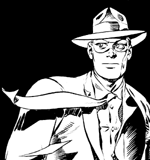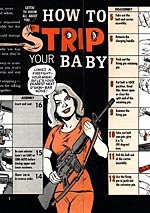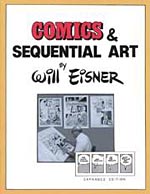
First published on Ninth Art on April 14th 2003. Updated January 9th 2004.
EARLY DAYS
Will Eisner was born March 6th, 1917, in Brooklyn, New York, to Jewish Immigrant parents. He attended De Witt Clinton High School in the Bronx, where his love for art first began to flourish and where - in his school's newspaper - his first work was published.
In 1936 he contributed his first professional comic work to Wow, What A Magazine and started up his first ongoing adventure serial, 'Hawks Of The Sea', a rapid sea story that sprang out of 'The Flame'. Wow sadly went bankrupt after the first couple of issues, but it lasted long enough to give Eisner one important contact.
LANDMARKS
1936 - After Wow went under, freelancer Eisner needed a new source of income. Collaborating with former Wow editor Jerry Iger, he created a studio, Eisner & Iger. Eisner's name ran first because he had put up the money: fifteen dollars, which paid for the first three months' rent. Employing the likes of Bob Kane, whom Eisner knew from his high school days, and Jack Kirby - then still Jacob Kurtzberg - the studio generated a steady flow of comics work.
Eisner sold his share of the business to Iger and left in 1939 to work for the Quality Comics Group, a move that would lead him one step closer to fulfilling his dream of making comics for adults.
 1939 - At the Quality Comics Group, Eisner created a mask-wearing, suit-clad, resurrected-from-the-grave detective named The Spirit, arguably Eisner's most famous creation. Tucked into Sunday newspapers, the 16-page colour Quality Comics supplement would eventually reach a circulation of five million readers through twenty different newspapers. It didn't take long for the comics section to be renamed "The Spirit Section".
1939 - At the Quality Comics Group, Eisner created a mask-wearing, suit-clad, resurrected-from-the-grave detective named The Spirit, arguably Eisner's most famous creation. Tucked into Sunday newspapers, the 16-page colour Quality Comics supplement would eventually reach a circulation of five million readers through twenty different newspapers. It didn't take long for the comics section to be renamed "The Spirit Section".
The Spirit Section featured three complete stories, THE SPIRIT being the longest of the three, running eight pages at first, and later seven. One of the biggest innovations credited to The Spirit Section - but far from the only one - is the invention of the 'splash page', a full-page action or event panel that Eisner would draw in order to hook in newspaper readers who'd casually flip through the paper. THE SPIRIT also featured innovatively designed titles and credits; rather than having a consistent logo, THE SPIRIT's title was always changing, always adapting to the specific surroundings of the story.
1942 - With World War II in full swing, Eisner's duties on The Spirit Section were interrupted when he was drafted into the army, although the comic was continued by others. Eisner kept himself busy and his pencil moving, illustrating posters, strips and training manuals for the military, as well as new comics, including the memorable 'Joe Dope'.
His instructional publication, 'Army Motors', proved so effective that, years later, even after his stint in the army had come to an end, Eisner continued to create instructional cartoons, forming the American Visuals Corporation, a commercial and educational art company, in 1950. This was done at the request of the army, which commissioned Eisner to revive 'Army Motors' as 'PS Magazine' for the Korean War.
1952 - After returning from the army towards the end of 1945, Eisner resumed work on THE SPIRIT. However, in 1952 he decided it was time to lay THE SPIRIT down - this time intending to keep him six feet under - in order to move on to more profitable commercial work.
Eisner concentrated his efforts on The American Visuals Corporation and its subsidiary companies, like Educational Supplements, which worked to provide social enrichment material for schools, such as a comic book JOB SCENE, which intended to introduce work ethics to high school flunkies. His clients included RCA Records, the American Red Cross and General Motors.
Around this time, Columbia Pictures wanted to turn THE SPIRIT into a TV series. Eisner, unhappy with the terms laid out before him, walked out of the meeting.
 1965 - Jules Feiffer's book THE GREAT COMIC BOOK HERO was released. It included THE SPIRIT reprints, which revived interest in the character and kickstarted an avalanche of other reprints, first by Warren and later by Kitchen Sink - a duty that has now been taken up by DC with its COMPLETE SPIRIT ARCHIVES.
1965 - Jules Feiffer's book THE GREAT COMIC BOOK HERO was released. It included THE SPIRIT reprints, which revived interest in the character and kickstarted an avalanche of other reprints, first by Warren and later by Kitchen Sink - a duty that has now been taken up by DC with its COMPLETE SPIRIT ARCHIVES.
1978 - While THE SPIRIT was being reprinted, Eisner continued to work away at the American Visuals Corporation, and his next big contribution to the comics industry wasn't released to the public until 1978, the year in which he is credited as bringing 'the graphic novel' to the world. Eisner invented the term in order to sidestep having to pitch his new book as a mere 'comic book'.
Eisner spent two years drawing and writing the book before finally releasing A CONTRACT WITH GOD to an unsuspecting public. First published by Baronet Books, this thick-spine graphic novel contains four short comic stories, interconnected through their setting - one very familiar to its creator, the Bronx tenements of the 1930s. With a set of stories that recalled his youth, Eisner was able to push the comics medium forward.
1983 - LIFE ON ANOTHER PLANET, Eisner's only all-science fiction book in print, was reprinted from serialized material. It had originally run during 1978-1980 in Will Eisner's Spirit Magazine.
LIFE ON ANOTHER PLANET is the story of 'a signal from space' - the original title of the book for the first printing. It is moralistic and human, but ultimately silly and dated - the science is laughable, obvious typos spoil aspects of the book, and the political satire is now largely passé. Still, there's something incredibly charming about Eisner's realistic approach to a far-fetched event.
1985 - Eisner introduced the essential book for true comic fans and aspiring creators: COMICS AND SEQUENTIAL ART. A "how to" guide for comics, it's rivalled only by Scott McCloud's UNDERSTANDING COMICS (which was undoubtedly influenced by Eisner's book). Based on a Sequential Art course Eisner taught at New York's School of Visual Arts and a series of essays he wrote for The Spirit Magazine, this book breaks down every aspect of the form, from page layout to inking, offering far more than just the paint-by-numbers 'how to draw' approach of most comic book guides. It was expanded in 1990 to include a section on print and computers.
 1986 - In THE DREAMER, Eisner shared his fondest memories of starting out in the comic world. For readers with a passion for comics' golden age, this book is a real treat. While names are changed, all of the golden age creators are present, including Jack Kirby, Bob Kane and, of course, Will Eisner himself.
1986 - In THE DREAMER, Eisner shared his fondest memories of starting out in the comic world. For readers with a passion for comics' golden age, this book is a real treat. While names are changed, all of the golden age creators are present, including Jack Kirby, Bob Kane and, of course, Will Eisner himself.
1991 - TO THE HEART OF THE STORM is considered by many to be the pick of Eisner's autobiographical works. A young man aboard a World War II troop train thinks over the life he's leaving behind: not just the memories and the stories, but also the anti-Semitism he hopes to escape.
1993 - Eisner swept through the Harvey awards, winning 'Best Writer' and 'Best Cartoonist' for his graphic novel INVISIBLE PEOPLE, a book about the people that we pass every day as we scuttle along the street. Eisner claims the stories "grew out of my dismay".
1995 - DROPSIE AVENUE: THE NEIGHBORHOOD. Eisner revisits the avenue where A CONTRACT WITH GOD and A LIFE FORCE took place, showcasing the centuries-old history of the neighbourhood, and demonstrating that the more things change, the more they stay the same.
2000 - Eisner produces LAST DAY IN VIETNAM, another book grounded in autobiography - Eisner was shipped off by the army to Korea and Vietnam during the wars so that his instructional books would be more authentic. Eisner attempted to make the audience much more a part of the story than just a passive reader. This was the first new Eisner work published after Kitchen Sink, Eisner's former publishing home, folded.
Also of great import in 2000, DC Comics began to reprint all of the SPIRIT comics chronologically in THE SPIRIT ARCHIVES, a truly formidable task. Expected to eventually reach 25 volumes, these hardback archived books are as difficult for the publishers to produce as they are for consumers to buy, what with the fifty dollar price tag.
Eisner's own collection of original art only dates back to 1945, so DC has had to pick up individual issues of The Spirit Section from collectors in order to build the archive. It then has to bleach out the colours, while keeping the original line art intact, then recolour the pages in a style that matches the originals, in respect to Eisner's wish that the books look as close to the originals as possible.
Regarding the reprints of THE SPIRIT, Eisner stated in an interview in Comic Book Artist #4; "I would rather have Jim [Warren] do it than Marvel or DC because I felt if I did it with them, I would soon lose any personal connection with it."
LATTER DAYS
FURTHER READING:
Will Eisner.com
Denis Kitchen's Eisner Biography
Will Eisner continued to work as hard as ever at his Florida home in his final years, producing a number of new graphic novels and adaptations, including NEW YORK: THE BIG CITY, THE NAME OF THE GAME, THE LAST KNIGHT, SUNDIATA: A LEGEND OF AFRICA, and FAGIN THE JEW.
Eisner died on January 3rd, 2005, at the age of 87, from complications following quadruple-bypass surgery. He is survived by his wife Ann and his son John.
His final book, THE PLOT, will be published by Norton in May. It traces the history of The Protocols of the Elders of Zion, an insidious work of propaganda that has fuelled anti-Semitism for generations. Those that have read THE PLOT have called it one of Eisner's most important works. It should prove a worthy final chapter to an extraordinary career.
NINTH ART RECOMMENDS
THE SPIRIT ARCHIVES: While they do carry the hefty price tag of $49.95 each, the stories presented here are a terrific collection of tales. Ranging from the heartbreaking to the hilarious, these stories encompass a stunning variety of themes and ideas, all the while showcasing Eisner's art and design ability and his incredible inventiveness. Whether you're into science fiction or marital dramas, THE SPIRIT has something for everyone to love.
COMICS AND SEQUENTIAL ART: Will Eisner's testament to how comics work. Here Eisner broke up the clock of comics, removed the gears and laid them all out in an oily puddle on a table, displaying them for all to see. This is the book for people who have wondered how and why comics work, and how they can be so effective in evoking an emotional response.
EISNER ON EISNER
"There's always a new challenge, and my style is to constantly explore or experiment, so I'm constantly probing beyond what I've done before. I'm never happy with what I did yesterday - not because I think I did a bad job, but because there's more to do. This is a medium that has not fully reached its potential." - Will Eisner, The Onion AV Club, September 27, 2000.

This article is Ideological Freeware. The author grants permission for its reproduction and redistribution by private individuals on condition that the author and source of the article are clearly shown, no charge is made, and the whole article is reproduced intact, including this notice.


